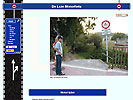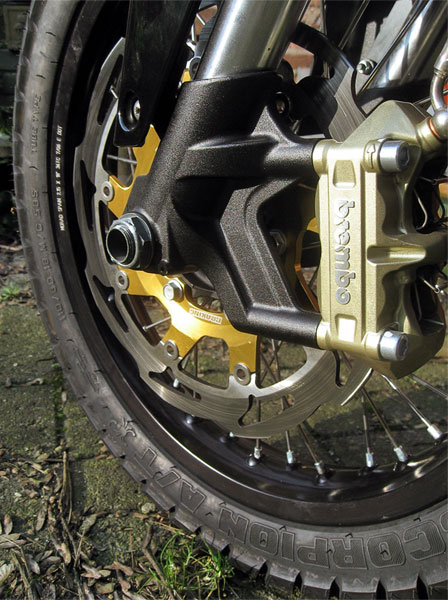
In the Netherlands, beginning motorcycle riders are taught how to brake. In many countries, starting motorcycle riders have to find out how to brake well themselves.
But even when you did receive lessons in braking, it is advisable to keep practising, especially when you change bikes.
This page summarizes how to brake in different circumstances and on different motorcycle.
How do you brake in case of an emergency stop? Ans you achieve the shortest stopping distance? And which difference does the kind of motorcycle you ride make? And how and when do you use the front and the rear brake?
![]() Er is een Nederlandse versie:
Er is een Nederlandse versie:
https://www.luiemotorfiets.nl/tips/bochten/
Braking and grip
To be able to brake, you need grip. So before reading about braking, it's good to knwo what influences grip.
What is grip?
Intuitively, everybody knows what grip is, and especially, what little grip is:
You will almost certainly brake very carefully on a slippery road, and rightly so.
But what is grip exactly?
Grip is friction, grip is the resistance that the tire feels with the surface of the road.
Withour friction of the air and of the road, a motorcycle wouldn't need any fuel, after reaching the desired speed. But unfortunately, because we live in an imperfect world, full of friction, we do need fuel.
That same friction of the road surface, that same grip, is of use, because you need it to accelerate (the tires push themselves against the surface of the road), and to decelerate, to brake.
Grip and weight
The more weight on a tire, the more grip, because the rubber is, so to speak, pushed into the surface. This is intuitively true: more weight pushes harder.
It's easier to shove a bit of Balsa wood forward on a rough surface, than a bit of lead.
So, the more weight, the better the braking?
So it seems as though your braking distance will be shorter as your motorcycle
is heavier; trucks then would have an ultra-short braking distance...
So that's not how it works.
When you brake, the weight of the motorcycle works against the braking distance as well as in favor of it, because the motorcycle will tend to keep its speed, the more weight, the more reluctance to decelerate. So you need more braking power to stop the bike.
Weight and grip
These two mechanisms compensate each other: more weight means more grip, but you will have to use that extra grip to have more braking power, which you need to stop that weight.
Weight and braking

Weight distribution over two wheels
So, when braking, the advantage of more weight vanishes because of the disadvantage of having to stop that same weight.
But that compensation only applies to the total weight. With a motorcycle, the weight is distributed over two wheels, and that distribution is not always exactly 50%.
No weight: no grip
When you look at the boy in this image, pulling a wheelie, it's clear that
braking with the front brake is of no use in that situation: the front wheel
even doesn't have any contact with the ground; all the weight is carried
by the rear wheel.
Using the front brake would result in stopping the front wheel, but a stopping
front wheel does'nt brake the bike when ir carries no weight.
Tips: when you have a motorcycle which gladly pulls a wheelie (wanted or unwanted), always keep your right foot near the brake. You only have to touch the rear brake to bring the front wheel down again.
The rear brake does make sense in that situation: when the rear wheel tries to stop turning, it will make the motorcycle itself stop.
Locked wheel
Keep in mind that a wheel will lock easier when it carries less weight.
This is sometimes felt as counterintuitive: when you ride downward, some motorcycle riders
think, the front wheel already has so much responsibility, you shouldn't
fatigue it by using it to brake as well. You'd better use the rear brake.
But in reality, it is exactly the opposite!
Downward slope
If you would heavily use the rear brake while riding a downward slope, the rear tire will soon loose all it's grip, lock, and will try to pass the front.
So always use the front brake while riding downward, even if it's counterintuive to you.
Suspension and grip

Contact with the road
In order to brake, you need grip, we just saw, and in order to have grip, you need good contact between the tire and the road.
That's why springs and suspension influence to a great extent how hard you can brake: they are responsible for the contact between the tire and the road.
Dive
A motorcycle with conventional springs will dive during braking. That illustrates the fact that during braking, the weight of the motorcycle will shift to the front wheel.
The motorcycle would like to keep its speed (because of its weight), but that's impossible because the wheels are forced to turn slower. The motorcycle will then try to turn around the front wheel, so to speak.
In case of a "stoppie" (the rear wheel lifts), it succeeds in doing so: the rear wheel lifts from the ground. (to prevent any misunderstanding: a stoppie does not mean that the front wheel locks!)
Weak front
Because of the diving, a motorcycle with weak front springs and suspension, will become uncontrollable while braking hard: the springs will reach their bottom, and then the contact with the road will disappear with every unevennness of the road (this is called "stamping").
So, when your springs are worn, it's not only a matter of less comfort, but more importantly, it will become impossible to brake really hard.
It also means that with motorcycles that don't have stiff springs (many allroads for instance), you will have to practise a lot, to achieve optimal braking: as hard braking as is possible with that suspension.
Anti-dive
Anti-dive systems, like the BMW telelever, prevent the springs of having a negative influence on the behaviour while braking. Unfortunately, the BMW system is about the only anti-dive system that is available at this moment: most motorcycles just dive while braking.
Optimal braking
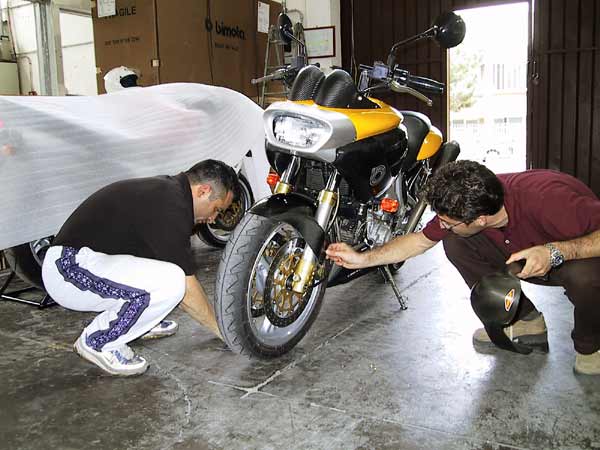
Alright, enough theory. Time for practice: how do you brake optimal.
Start with the rear brake
When you want to brake with the shortest possible braking distance, you start by using the rear brake. Of course, you don't slam it. In fact, you only use the rear brake to start a process of shifting weight from the rear to the front wheel. This will cause the springs to get contracted, which will decrease the chance of a lifting rear wheel, and which will stabilize the bike.
A little bit later the front
By using the rear brake first, there is already more weight on the front wheel at the moment that you start using the front brake. Because of that, you can squeeze the front brake harder than when you would have started braking with the front brake.
Lay on and squeeze through
But even then, it is not advisable to squeeze the front brake as hard as you can, at least not in the beginning. You should start gently and then squeeze on while the weight keeps shifting to the front, because the grip of the front wheel will then be at its best.
To imagine what "squeeze on" means, imagine squeezing half a lemon.
Squeeze on
It is here that many motorcycle riders don't get out of their bike what it is capable of. Maybe, when you realize that at this point, the front wheel really has the most grip, you will be able to squeeze the handle as hard as you can.
Speed
With a lot of speed, you will be able to brake really hard: because of the high speed, shifting the weight to the front will take place with speed as well, and that means that you can start earlier squeezing the front brake.
When you ride fast, even sitting upright will decelerate the bike considerately. On the other side, the same resistance of the air will slow down the shifting of the weight to the front, so even then, start using the rear brake.
No rear brake
At the moment that you can use much front brake, the opposite is true for the rear brake: there is almost no weight on the rear wheel.
So, after touching the rear brake, let it go.
Differences between motorcycles

These tips on how to brake optimal though, cannot tell you much about exactly how long you should keep using the rear brake, or at which moment you can start really squeezing the front brake: that's different for each motorcycle.
Sometimes almost no rear brake
On a motorcycle that has a lot of weight on the front even without braking, you should let the rear brake go almost immediately (it always pays to use it at the start!).
Motorcycles with that property have a short wheel base, and their front wheel is almost directly under the steer: sporty motorcycles.
Sometimes a lot of rear brake
On other motorcycles, you should keep the rear brake working during the whole braking maneuvre. Those are motorcycles with a long wheel base, and a front fork that sticks out to the front, which prevents the weight to be carried all by the front wheel.
The most extreme form are dragracers. Cruisers have the same geometry but a bit less radical. Their geometry has the property that the braking distance is longer than on sport bikes, and also that you need the rear brake during braking to get the most out of it.
Geometry
So, in short, hard braking methods differ depending on the kind of bike and its design. Sports bikes have shorter wheel base lengths and steeper frame geometry hence they have more weight forward than a long wheel base cruiser or a loaded tourer. Road bikes will come in the middle and therefore will vary.
Essentially, hard braking with the rear brake first is to push weight forward and so is done whilst riding cruisers and tourers and road bikes. Cruisers will use the rear brake during the whole manouvre.
With sports bikes, you will only lightlu touch the rear brake for a very short momen (or only applie the front brake, if that's too difficult).
Remember that carrying a pillion will certainly demand the use of the rear brake first.

Luggage
With a heavily loaded motorcycle (a pillion rider, camping gear), your motorcycle will shift its weight during braking less than you are used to. In that case, you will have to use the rear brake more that you are used to, for an optimal braking distance.
Watch out when squeezing
On a motorcycle that dives heavily, you should be carefull while squeezing the front brake: if you brake so hard that the front springs are pushed in to their full capacity, your front wheel will lock very easily, and if this prolongs, the motorbike will slide down.
On motorcycles with a long suspension travel, you should be aware of the fact that
it will take longer before the front wheel has enough weight, which means that
it will take longer before you can squeeze really hard.
There is a great risk of locking the front when squeezing too soon.
The same applies for motorcycles that need the rear brake during the whole braking maneuvre: they don't get enough wieght on the front to really use the front brake to its maximum.
In sport bikes, the opposite is true: you should watch out for the rear wheel lifting from the ground. That is easy to control, by loosen you grip on the brake handle a bit.
When your rear wheel lifts, you know for sure that until that point, you were braking to the maximum.
An emergency stop

In theory
In theory, you should, of course, brake optimal in an emergency situation: in that case, you have the shortest possible braking distance, and that's exactly what is needed.
But in practice, that's hard to achieve at a moment where panic comes around the corner.
The danger is that you, next to squeeze the front brake (which is perfect if you do it like squeezing a lemon, and not all in once), also will slam the rear brake, and hold on to it, which is not ok.
Pull the clutch and use the front brake
For a real emergency stop, you can better leave the rear brake for what it is, and only use the front brake. On top of that, you pull the clutch.
Why no rear brake?
It is very difficult not to slam the rear brake in an emergency situation, and especially to let the rear brake go in time. If your muscles get tense in such a situation, the tendency is to push the rear brake hard with your foot.
That will result in a locked rear wheel. If you are lucky, it will slide from left to right and back, and if you are less lucky, the rear wheel will move passed the front wheel.
In an emergency situation, you don't want that.
That's the reason for the advice not to touch the rear brake in an emergency stop.
As a bonus, the bike will stay upright, because the rear wheel will keep turning. A turning wheel has resistance to move sideways.
Why pull the clutch?
You would think that it is not wise to pull the clutch, because you would profit from the engine brake.
The engine is capable of braking the motorcycle a bit when you stay off the throttle, but it also resists more deceleration. And because you should brake much harder than the engine brake, you pull the clutch.
How to practise?
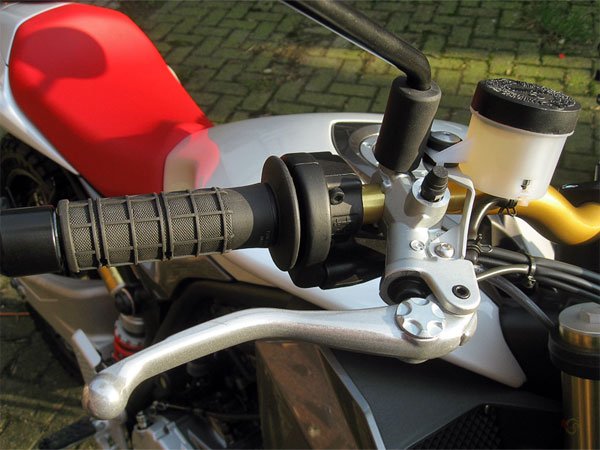
New motorcycle
In the first place: when you just bought a new motorcycle (first or second hand), it is very important that you practise braking with it, even if you ride motorcycles for twenty years or longer! There is a difference between having an idea of what your bike can do and knowing through practice just how it behaves.
The distribution of weight, and the process of shifting weight while braking, is different with each motorcycle, and it's important that you can feel the differences.
With or without the rear brake?
While practising, there is a dilemma:
If you want to achieve optimal braking, you should use the rear brake.
But if you want to make sure that an emergency brake becomes an automatic action, you shouldn't touch the rear brake while practising.
A compromise could be to practise optimal braking from time to time on a vacant parking lot, and to brake in traffic in the manner of an emergency brake, pulling the clutch and staying off the rear brake.
Practice on a parking lot will teach you to feel what's happening with your bike, while your behaviour on the road will teach your muscles how to behave in an emergency brake, so to speak.
Take care at traffic lights!
When you practise your braking skills on the road, don't try too hard at a red traffic light: the tarmac there is often dirty, with spilled diesel and such, so it could turn out in a real emergency...
Locked wheels
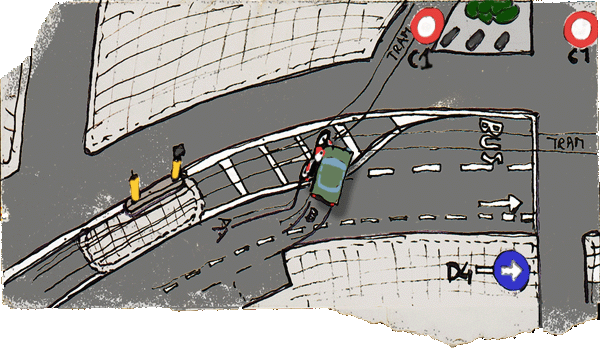
Less grip
The tire can have contact with the road in two ways: turning or sliding.
A sliding wheel has kinetic friction, while a turing wheel has dynamic or rolling friction. A sliding tire (with kinetic friction) doesn't have any stablility with respect to direction: it will slide very easily sideways. A turning wheel on the other hand, with rolling friction, will keep its direction.
A locked rear wheel, therefore, will sweep sideways, or even get passed your front wheel, which will result in going down.
A good explanation about friction and locking and sliding can be found on this page about on friction and automobile tires.

Practice
To get an idea about how a locked wheel feels, you could practise it once, in a controlled situation.
A locked rear wheel
You can lock the rear wheel on purpose by, on an even surface (no parking lot with cobblestones), slam the rear brake. You should stay off the front brake at the same time.
If your speed was enough, your rear wheel will "fishtail": it slides to the left and to the right, behind you.
Lock the front wheel
To lock your front wheel, you should ride with less speed:
From a standstill, with the front brake squeezed, open the throttle,
gently. You will then ride with a locked front wheel.
Unwanted locked wheel
So, what should you do in case of an unexpected locked wheel?
Both with the rear and front brake, it is a matter of letting the brake go, a little.
Braking with ABS

Different way of braking?
Some people believe that you should brake differently when your motorcycle has ABS: just slam the front and rear brake, and the ABS performs the braking.
What is true is that you won't lock the wheels, but your braking distance will be much longer than needed.
Why not slam the brakes with ABS?
When you slam the rear brake, the rear wheel will lock, almost immediately. So the ABS will take over immediately as well, braking and letting go the rear brake at a high frequency.
Therefore, it takes longer before the weight of the bike has shifted to the front wheel, than when you would brake carefully.
The front brake will not perform as it should as well: you squeeze the front brake hard at a moment when the weight distribution is far from optimal. So the front wheel will lock as well, and, the same as with the rear brake, the front brake will come in and let go alternately.
All in all, you will loose many costly meters braking distance.
Different ABS systems
In most ABS systems, the ABS engages before a wheel locks. Understandably, because the ABS is always slightly later than real-time: the values of the sensor should be checked and analysed, and the controller has to take action.
According to the tests, the ABS system of Ductati seems to be almost perfect. In other systems, it may engage (long) before a wheel locks. This means, of course, that you can't brake as hard as you could brake in theory.

Reactions on stoppies
Most ABS systems prevent the rear wheel from lifting. There are two kinds of control:
A limit to deceleration
In this case, deceleration (the degree of braking) is simply kept below a certain value. You can never brake harder than that value, and with that value, the rear wheel will not lift.
Front brake reacts to rear wheel lock
In this case, the ABS system will react at a locked rear wheel: when you use the rear brake, and the rear wheel lifts, the wheel will lock instantly. If the ABS system detects a locked rear wheel, it will react by loosening the front brake.
That system can take you by surprise, for instance when riding a downward slope: when riding a downward slope, the rear wheel locks easily (there is almost no weight on it), and the ABS will let go of the front brake. You will notice the fact that suddenly, for a hairy moment, you don't have any brake at all.
Another situation where this can happen is on bumpy roads: the rear wheel may loose contact for a short time, and will lock when you use the rear brake.
It is difficult to get detailed information about these kinds of control.
As far as it's known, BMW uses the latter method, except for the F-models. Honda and Yamaha use the first method, and Ducati has no method at all: a Ducati with ABS can lift its rear wheel.
If you intend to perform stunts with your bike or want to ride rough roads and off road, then it's very convenient if you can turn the ABS off.
Practise!
What it all boils down to, is that you should practise, also when you your motorcycle has ABS.
When you can shutdown the ABS, also practise without ABS!
Braking in a corner

Adjust the speed
From time to time, you will misjudge a corner. The corner is tighter than it seemed, or it has a decreasing radius, or the surface of the road doesn't seem thrustworthy.
In that case, the best way to adjust your speed is to keep the throttle the same, and touch the rear brake slightly.
When you do that, the bike will not try to get upright. Instead, it will even turn in a bit more, and that's exactly what you need. (To help the bike a bit more, push it with your knee into the direction that it should go.)
Really brake hard
But sometimes it is necessary to really brake hard, while in a corner, You meet a combine, for instance, halfway the corner, or a cow.
Use the front brake
Really brake hard in a corner is possible. You should use the front brake.
You will almost never ride to the limit on the road, so there is room to brake, and even to brake rather hard, without going down. To brake hard, you should use the front brake, and you can, without going down.
Pull the clutch
When you wouldn't pull the clutch, and squeeze the front brake in a corner, your bike would get upright, and steer out of the corner. That is not always what you want.
That's why you need to pull the clutch, and you should actively push the bike into the corner, with your outside knee.
Practise
You should practise braking in a corner as well, from time to time. You will get experienced with what is possible, and you will automatically do what's necessary when it's needed.
Comments, Q & A, on a separate page




